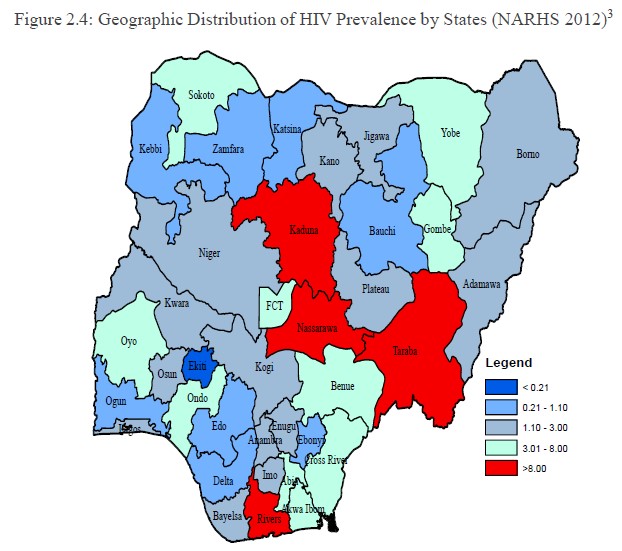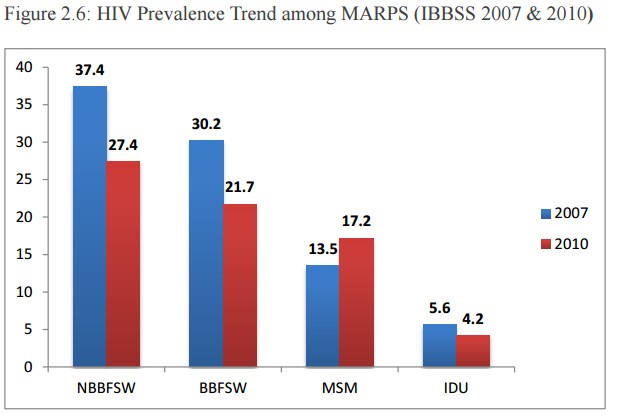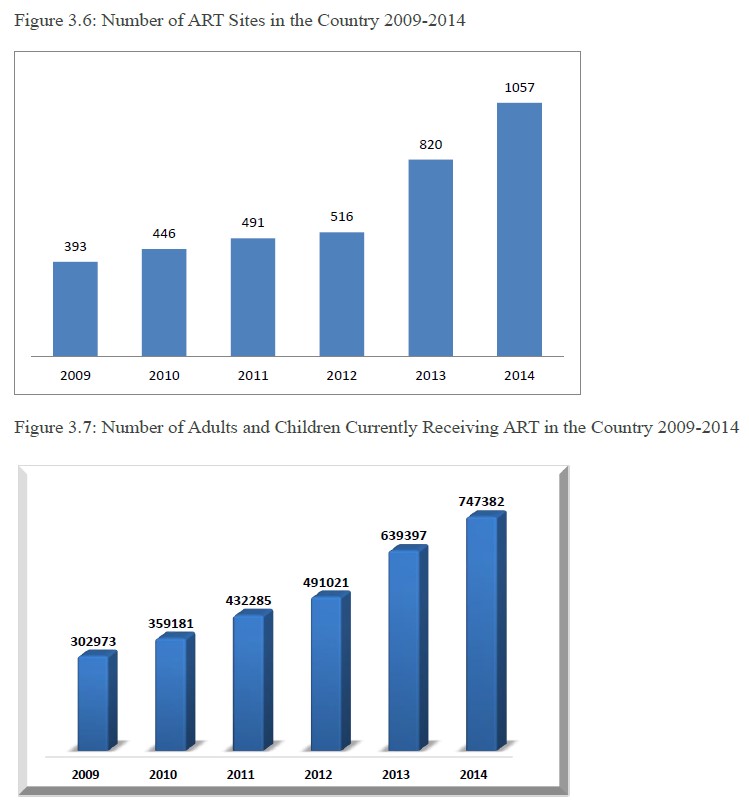Home > African Marke > Nigeria
Time: Jun 17, 2016
AIDS Epidemic and Response
AIDS epidemic in the country
Number of people living with HIV | 3,400,000 [3,100,000 - 3,700,000] |
Adults aged 15 to 49 prevalence rate | 3.2% [2.9% - 3.4%] |
Adults aged 15 and up living with HIV | 3,000,000 [2,700,000 - 3,300,000] |
Women aged 15 and up living with HIV | 1,700,000 [1,600,000 - 2,000,000] |
Children aged 0 to 14 living with HIV | 380,000 [350,000 - 410,000] |
Deaths due to AIDS | 170,000 [150,000 - 220,000] |
Orphans due to AIDS aged 0 to 17 | 1,600,000 [1,100,000 - 3,300,000] |
Source: HIV and AIDS estimates (2014)[1] from UNAIDS Data
General description: Nigeria’s epidemic is generalized, with wide variation in prevalence within the country. An analysis of the 2012 National HIV/AIDS and Reproductive Health Survey (NARHS) prevalence data in the country’s six geopolitical zones shows that the prevalence is highest in the South South Zone (5.5%) while the lowest prevalence is in the South East Zone at 1.8%. There are also differences between urban and rural areas with prevalence figures in urban 3% and 4% in rural area. The pattern of distribution of HIV prevalence by sex showed that irrespective of sex disaggregation, the HIV prevalence pattern is the same across all selected background characteristics.
Based on projected HIV estimates for 2014, about 3,391,546 are living with HIV in Nigeria while 227,518 new HIV infections occurred in 2014 (male 103,917 and female 123,601). A total of 174,253 died from AIDS related cases in 2014 which is lower than 210,031 people in 2013.
Although most at risk populations or key populations contribute to the spread of HIV, heterosexual sex, particularly of the low-risk type, still makes up about 80 percent. Mother-to-child transmission of HIV and transfusion of infected blood and blood products account for the other notable modes of transmission.
 The most recent NARHS was conducted in 2012, with a national prevalence of 3.4%, a slight decline from previous estimates of 2007 which was 3.6%. The overall national prevalence also masks several variations in Nigeria’s epidemic at the sub-national (state) levels and among different population groups. The 2012 prevalence was highest among those aged 35 to 39 (4.4%), and lowest among the 15-19 age group (2.9%). The prevalence for males aged 35 to 39 years was highest at 5.3%, while women aged 30 to 34 years was 4.2%. Geographically, the prevalence was highest in the South South zone.
The most recent NARHS was conducted in 2012, with a national prevalence of 3.4%, a slight decline from previous estimates of 2007 which was 3.6%. The overall national prevalence also masks several variations in Nigeria’s epidemic at the sub-national (state) levels and among different population groups. The 2012 prevalence was highest among those aged 35 to 39 (4.4%), and lowest among the 15-19 age group (2.9%). The prevalence for males aged 35 to 39 years was highest at 5.3%, while women aged 30 to 34 years was 4.2%. Geographically, the prevalence was highest in the South South zone.
Key drivers of the HIV epidemic in Nigeria include low personal risk perception, multiple concurrent sexual partnerships, transactional and inter-generational sex, ineffective and inefficient services for sexually transmitted infections (STIs), and inadequate access to quality healthcare services.
AIDS epidemic among key populations: based on comparison between IBBSS 2010 data for high risk groups and NARHS 2012 data for the general population, it is observed that key target populations or most at risk populations (MARPS) have a significantly higher prevalence than the general population. At the top of this group are the brothel-based female sex workers (BBFSW), with a current estimated prevalence of 27.4%. Non-brothel based female sex workers (NBBFSW) rank next with an estimated prevalence of 21.7%, followed by men who have sex with men with an estimated prevalence of 17.2%. While the HIV prevalence among FSW and transport workers is reducing, the prevalence is increasing among MSM: from 13.5% (2007) to 17.4% (2010).

National AIDS response
The HIV Prevention response is coordinated at the national level by the National Prevention Technical Working Group (NPTWG), chaired by National Agency for the Control of AIDS (NACA) and at the state level, by the state prevention technical working group hosted by State Agency for the Control of AIDS (SACA).
Key populations: The 2010-2015 National HIV Strategic Plan emphasizes behaviour change communication for HIV prevention among MARPs. NACA and its partners have developed the PEP model for peer educator training among these key populations. Part of this model is the Minimum Prevention Package Intervention (MPPI), which uses social networking approaches to reach hidden and stigmatized groups, and establishes referral systems to health services in MARP- friendly clinics. Specialized MARPs friendly training and capacity building are conducted for private and public sector healthcare service providers. In 2014, the following key populations were reached: Female sex workers 374,705; IDU 18,738; MSM 37,072; Armed Forces 21,353 and TW 52,383.
Testing: according to the NARHS 2012, 23.5% of male and 29.2% of female reported ever tested for HIV. Out of this group, only 63% of female and 68% of males that tested for HIV received their results and know their status. Thirty six percent of respondents’ aged 15 to 19 and 42.6% of those aged 20 -24 reported having an HIV test in the last 12 months. A lot more needs to be done to increase uptake of counselling and testing in order to achieve the access target for this objective.
 ART: the number of sites providing ART has increased from the 25 sites in 18 states in 2002 to 1057 in 2014 and spanning all 36 states + FCT. The number of adults and children currently receiving ART has increased to 747,382 persons as at 2014. This increased availability and use of cost effective antiretroviral drugs has had significant impact on the public perception of the disease, access to prevention services, disease transmission and occurrence of Opportunity Infections (OIs), quality of life, and life expectancy of people living with HIV.
ART: the number of sites providing ART has increased from the 25 sites in 18 states in 2002 to 1057 in 2014 and spanning all 36 states + FCT. The number of adults and children currently receiving ART has increased to 747,382 persons as at 2014. This increased availability and use of cost effective antiretroviral drugs has had significant impact on the public perception of the disease, access to prevention services, disease transmission and occurrence of Opportunity Infections (OIs), quality of life, and life expectancy of people living with HIV.
Prevention of mother-to-child transmission (PMTCT): The number of HIV pregnant women who received ARV prophylaxis to prevent MTCT increased from 57,871 in 2013 to 63,350 in 2014, an increase of about 9.5%. Also, there has been a marked increase in the number of HIV positive pregnant women who received family planning counselling from 54,867 in 2013 to 120,323 in 2014, an increase of 119.3%. Number of partners of HIV positive women who tested negative increased from 4,828 in 2013 to 17,167 in 2014. However, based on the 2014 estimates, the coverage for PMTCT still remains low at 30.3%. Challenges being experienced with the PMTCT program in Nigeria include: inadequate uptake of PMTCT services by pregnant women; minimal male involvement and poor community participation in PMTCT and inadequate number of EID facilities in the country.
Condom programming: In 2014, 32,000,818 male condoms and 5,073,743 female condoms were distributed. The Federal Ministry of Health and other NGOs also distributed some condoms. For sex workers, condom use has remained high among female sex workers (92.9% at last sex with client) and percentage of MSMs selling sex that used a condom the last time they had anal sex with a paying partner was 54.7%.
Challenges and actions
1) Weak infrastructural support (computers, internet facilities) for DHIS 2 electronic reporting at the LGA and facility level respectively;
2) Lack of integration of DHIS instances run by different Agencies/Department;
3) Another noticeable challenge of the M&E system is its failure to adequately capture the contributions of private sector to the HIV/AIDS response in Nigeria;
4) Weak collection system for data generated in non-health and private sectors;
5) Inadequate formal mechanisms for dissemination of research findings;
6) Evaluation of the impact and effectiveness of national HIV/AIDS programs and interventions have not taken place;
7) Data dissemination and use are still weak in the areas of evidence-based HIV programming;
8) Absence of a harmonized national M&E calendar of activities;
9) Limited number of trained health personnel in the area of monitoring and evaluation or strategic information to support data collection and reporting;
10) Data reporting from community outreaches is still weak.
[1] http://www.unaids.org/en/regionscountries/countries/nigeria/

